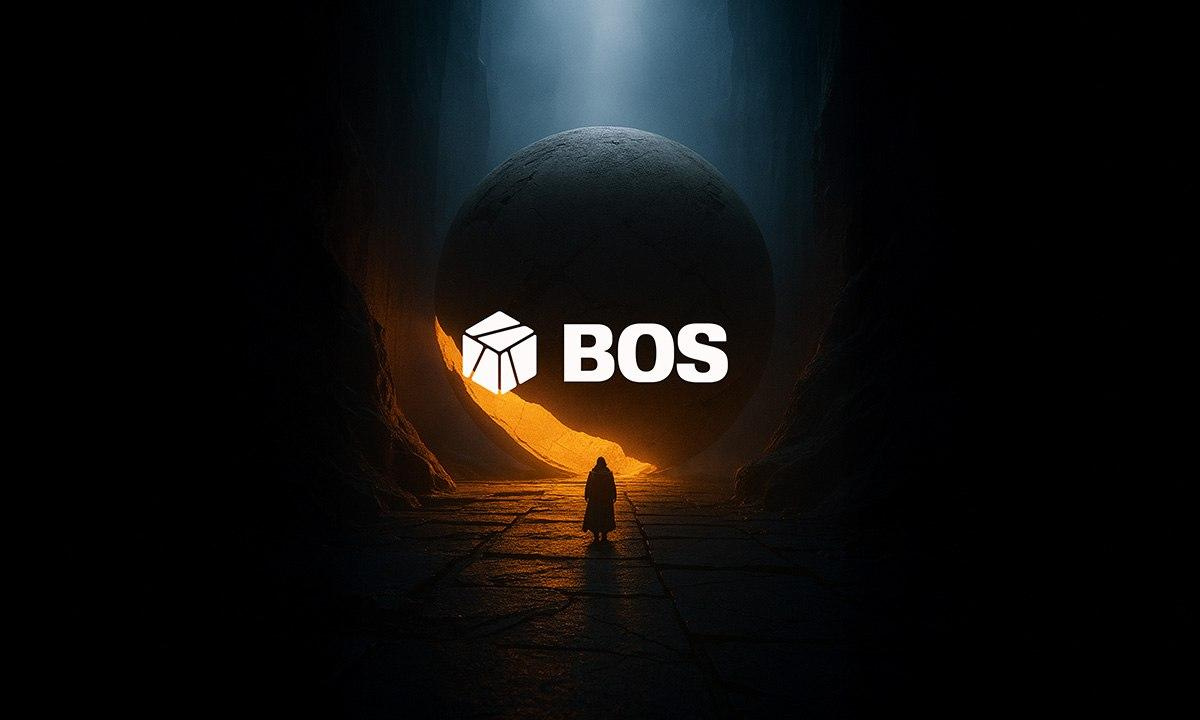BurnLive Feed
Burn breaking news and instant alerts. Crypto Feed's minimalist interface delivers verified headlines, price movements, and protocol updates the moment they happen. Fast, focused, no fluff.
 Ethereum Foundation Strengthens With Linea Becoming The Economic Backbone – See How
Ethereum Foundation Strengthens With Linea Becoming The Economic Backbone – See HowEthereum’s scaling era is evolving, and Linea is emerging as one of its most important pillars. By enabling faster, cheaper transactions while maintaining full ETH security and composability, Linea is building the infrastructure for real economic activity. Why Ethereum Needs An Economic Backbone Linea is rapidly evolving into the Ethereum economic backbone. Crypto analyst Henry has revealed on X that Linea was built from first principles as a reinforcement layer for ETH’s future. The reason why Linea is catching serious attention is that over $1 billion in Total Value Locked (TVL) and $130 million in stablecoins represent real liquidity inflow into the network, not inflated metrics. Furthermore, Linea’s buyback and burn mechanism ties are built directly into protocol revenue. MetaMask’s deep integration and the seamless user experience (UX) are instant reach, and the developer-first architecture actually scales without breaking ETH’s security. The rumors of a MASK airdrop and upcoming institutional deployments only add fuel to the narrative. While others are chasing hype, LineaBuild is constructing the infrastructure that powers real revenue. Henry concluded that every stat is screaming one thing, and adoption is real. “Nothing can defeat this, and Linea is ETH’s execution layer for the next cycle,” the expert added. Crypto analyst BullifyX has also made a bold declaration that the next evolution of Web3 is unfolding right on LineaBuild. Linea isn’t just another Layer 2 blockchain, but it’s a new foundation for scalability, speed, and developer freedom. With zkEVM precision, ultra-low gas, and ETH-grade security, Linea bridges the gap between innovation and accessibility. Furthermore, LineaBuild is a frictionless playground for builders, while for users, it delivers pure performance. BullifyX emphasizes that Linea’s role is to transform complex blockchain experiences into smooth, scalable realities, powering applications, digital economies, and the immersive metaverses. “The future doesn’t wait. It scales on LineaBuild.” BullifyX noted. The First Public Company Just Proved Ethereum’s Real-World Use Case In a monumental shift, the institutional adoption of Ethereum had just leveled up. According to Stacy Muur, the founder of GREENDOTS, the catalyst for this advancement is the deployment of an impressive $200 million in ETH on LineaBuild by SharpLink, a publicly traded company, powered by EigenLayer’s EigenCloud, ether_fi restaking, and Anchorage for secure, regulated custody. Muur explained that this is the first fully verifiable, ETH-aligned institutional treasury activation. Meanwhile, a public company is now using EigenCloud as infrastructure for staking and verifiable on-chain treasury management. This suggests that the ETH restaking economy is robust enough to regulate capital.
 Forget Cardano, Why Shiba Inu’s Shibarium Is The Real Ghost Chain
Forget Cardano, Why Shiba Inu’s Shibarium Is The Real Ghost ChainShiba Inu’s effort to grow beyond being a meme coin is struggling. Its blockchain network, Shibarium, was created to bring real use and value to the project, but it has not gained much attention or activity. Developer interest and user engagement are very low, and the network’s overall growth has slowed down sharply. Recent network issues, including technical troubles and security problems, have made things worse. Many users have left, and new projects are not joining. As a result, Shibarium now shows very little activity, leading many in the crypto community to call it a “ghost chain.” Shiba Inu’s Struggle To Evolve Beyond A Meme Coin Shiba Inu tried to change its image from a simple meme coin into a real blockchain project capable of competing with other networks. The team launched Shibarium, a layer-2 blockchain, in 2023 to help make this move. However, this plan has not worked as expected, with Shibarium failing to attract developers, projects, or users and gaining no market share. According to data from DeFi Llama, Shibarium has only 18 developers since it began. It is a much lower number than on other blockchains, which have hundreds or even thousands of active developers. The total value locked (TVL) on the network, which shows how much money people have invested in it, has fallen to just $878,000. Shibarium has also failed to attract any stablecoins, which are among the most widely used tokens in decentralized finance. Not a single stablecoin project has deployed on the network, reflecting Shibarium’s lack of presence in one of the most critical areas of the crypto world. Other newer and more active layer-2 networks like Base, Arbitrum, Plasma, and Linea have already moved far ahead, leaving Shibarium behind. Hacks And The Decline Of Shibarium Network Activity Things got worse for the network when ShibaSwap, the most popular decentralized app (dApp) on the Shibarium network, was recently compromised. The attack eroded user confidence and forced developers to pause a key bridge connecting Shibarium to other networks. Even with the bridge now active, most of the network’s activity stopped. Many users could not move their tokens or use apps, making the network almost entirely silent. Because of this drop in network activity, Shibarium is no longer helping burn SHIB tokens. Typically, a portion of network transaction fees goes toward buying and burning Shiba Inu tokens, helping reduce supply and support the token’s price. But now, with very few transactions, the burn process has slowed down significantly. The decline in users, developers, and activity are indicators that Shibarium’s dream of becoming a strong, useful blockchain has not come to fruition. Instead of growing into a central crypto platform, it has become what some would call the real ghost chain.
 NEAR Cuts Inflation Rate by Half Despite Failed Community Vote
NEAR Cuts Inflation Rate by Half Despite Failed Community VoteNEAR Protocol has upgraded its network with a new update that reduces its annual token inflation rate from 5% to roughly 2.4%, even though the community vote intended to authorize the change failed to reach the required threshold.The NEAR Protocol team announced today, Oct. 30, that it had completed the upgrade. The so-called halving upgrade curbs token dilution caused by nearly 60 million new NEAR tokens minted annually due to minimal fee burns, while also realigning incentives for on-chain participation and lowering staking yields from roughly 9% to 4.5%, assuming half of the total supply remains staked.To continue reading this as well as other DeFi and Web3 news, visit us at thedefiant.io
 Bitcoin Dumps to Weekly Lows as Liquidations Skyrocket to Over $1.1 Billion
Bitcoin Dumps to Weekly Lows as Liquidations Skyrocket to Over $1.1 BillionNearly a billion worth of long positions have been wrecked in the past 24 hours as the positive macro developments have failed to propel a price rally for risk-on assets like crypto. Just the opposite, bitcoin and most altcoins have headed south once again in the past hour, with numerous weekly lows. BTCUSD. Source: TradingView The promises of an Uptober have crashed and burned in 2025 as the market has failed to produce any substantial gains since the early surge to a new all-time high. Bitcoin’s chart from above demonstrates that the asset has been in a free-fall state ever since that peak marked on October 6. Even if we exclude the flash crash four days later, BTC is still nearly $20,000 down in just over three weeks. The asset was rejected at $116,000 twice in the past four days, and the bulls put all hopes on yesterday’s Fed rate cut and today’s meeting between Presidents Donald Trump and Xi Jinping. Both of those events led to what the investors expected and hoped for: a reduction in interest rates and lower tariffs on China. Yet, the cryptocurrency market failed to capitalize. Just the opposite, bitcoin slumped from over $112,000 yesterday to $107,500 minutes ago, which became a new weekly low. The market leader’s nosedive dragged the altcoins along, with ETH dumping by 5% to under $3,800 and XRP dropping by over 6% to $2.45. Even more painful declines come from the likes of HASH (-22%), ASTER (-13%), KAS (-11%), PI (-10.5%), WLFI (-10%), and many others. Such big moves in either direction tend to harm over-leveraged traders, and the correction in the past 24 hours is no different. More than 210,000 such market participants have been wrecked daily, while the total value of liquidated positions has skyrocketed to more than $1.1 billion. Naturally, almost all of that amount came from longs ($974 million). Liquidation Data on CoinGlass. The post Bitcoin Dumps to Weekly Lows as Liquidations Skyrocket to Over $1.1 Billion appeared first on CryptoPotato.
 XRP Burn Rate Skyrockets 200%: Is This Growth Sign?
XRP Burn Rate Skyrockets 200%: Is This Growth Sign?XRP is seeing a substantial burn rate spike, which is an important sign of market activity that might transform into price action.
 JPMorgan is Taking Metamask Public: Will MetaMask ICO Land Before MetaMask Airdrop?
JPMorgan is Taking Metamask Public: Will MetaMask ICO Land Before MetaMask Airdrop?The MetaMask airdrop narrative is heating up again after fresh reports confirmed that JPMorgan and Goldman Sachs have been brought on to lead Consensys’ initial public offering (IPO). Consensys, the company behind the widely popular MetaMask wallet, is reportedly eyeing a late 2025 or early 2026 listing, potentially marking one of the biggest public offerings in crypto’s history. With over 100 million MetaMask users worldwide and persistent chatter around a MetaMask ICO and MASK token, investors are now asking one burning question. Will the airdrop arrive before the IPO, or will both events coincide in a single massive rollout? Market Cap 24h 7d 30d 1y All Time Is JPMorgan Really Taking MetaMask Public? Consensys, led by Ethereum co-founder Joseph Lubin, has hired JPMorgan Chase and Goldman Sachs to manage its IPO. The move signals a significant leap forward for one of Ethereum’s most influential structure firms, fresh off a key regulatory victory. JUST IN: MetaMask maker Consensys selects JPMorgan and Goldman Sachs as lead underwriters for its IPO, per Axios. pic.twitter.com/qxxtn64NoE — Cointelegraph (@Cointelegraph) October 29, 2025 Earlier this year, the SEC dropped its lawsuit against Consensys over MetaMask’s staking features, removing one of the final barriers before a potential listing. The company, last valued at around $7Bn in 2022, builds foundational tools for the Ethereum ecosystem, including MetaMask, Infura, and the Linea Layer-2 network. (Source – tracxn) The IPO would give traditional investors a rare opportunity to buy exposure to Ethereum’s expanding ecosystem. Meanwhile, Consensys has doubled down on its Web3 ambitions, reportedly planning to invest $200M into DeFi and yield-generating strategies on Linea. This will further strengthen MetaMask’s integration with on-chain finance. DISCOVER: 10+ Next Crypto to 100X In 2025 Will a MetaMask ICO Launch Before the MetaMask Airdrop? So far, there’s no official MetaMask ICO, and none confirmed to be coming. Despite years of speculation about a MASK token, Consensys has not announced any sale or token issuance. Instead, attention has shifted toward the ongoing MetaMask Rewards Program, which many believe is laying the groundwork for a future airdrop. Getting started with MetaMask Rewards is easy. Just opt-in on mobile and you're on your way. pic.twitter.com/wWbJjhBkSO — MetaMask.eth (@MetaMask) October 29, 2025 This reward campaign allows users to earn points for actions such as swapping tokens, bridging assets, and staking directly in MetaMask. The points system has quickly become a talking point among DeFi users, offering rewards such as Linea tokens, fee discounts, and potential eligibility for a MASK airdrop. While a few domain names, such as claim.metamask.io and gift.metamask.io, have intensified community speculation, Consensys hasn’t confirmed any official airdrop timeline or token details. Analysts expect that if a MASK token does appear, it will take the form of a governance or utility token, launched via a fair distribution rather than a traditional ICO – aligning with the company’s cautious, regulation-first approach. DISCOVER: 15+ Upcoming Coinbase Listings to Watch in 2025 When Could the MetaMask Airdrop or Token Launch? If the MASK token does launch, it could become one of the most anticipated events in DeFi history. MetaMask’s 10 million unique user base gives it unprecedented reach, and a token release (especially alongside ConsenSys’ IPO) could ignite a wave of retail participation. (Source – dune) Recent patterns suggest the MetaMask airdrop could take place in early 2026, potentially coinciding with the IPO itself. The dual headlines would be strategic: one introduces Consensys to Wall Street, while the other energizes the Web3 community with a fresh token ecosystem. Analysts expect that if a MASK token hits the market, Metamask price volatility could mirror early UNI or ARB surges, as users rush to claim, stake, and trade their rewards. DISCOVER: 16+ New and Upcoming Binance Listings in 2025 Join The 99Bitcoins News Discord Here For The Latest Market Updates Key Takeaways JPMorgan and Goldman Sachs to lead Consensys IPO. Is the MetaMask token going to launch before the airdrop? The post JPMorgan is Taking Metamask Public: Will MetaMask ICO Land Before MetaMask Airdrop? appeared first on 99Bitcoins.
 BitcoinOS $BOS Token Is Live On Binance Alpha And Top Tier CEX Listings, Advancing Institutional BTCFi
BitcoinOS $BOS Token Is Live On Binance Alpha And Top Tier CEX Listings, Advancing Institutional BTCFi[PRESS RELEASE – London, United Kingdom, October 29th, 2025] $BOS token to go live both as an ERC-20 on EVM chains and as a CNT on Cardano. Today, BOS (BitcoinOS), the unifying operating system transforming Bitcoin for digital economies, has officially launched the $BOS token at $200 million FDV, trading is live on Binance Alpha along with Kucoin, Gate, Kraken US, Bitget, MEXC, and PancakeSwap DEX. The $BOS token is positioned to fulfill critical functions, serving as the incentive layer to ensure that the BOS network remains secure, performant and decentralized. While computation and verification happen on Bitcoin, a specialized node network is required to: Generate ZK proofs from computation Monitor the system for fraudulent activity Submit challenge transactions to Bitcoin when fraud is detected Provide verification services for non-technical users BOS aims to maximum value accrual by operating a buy-and-burn mechanism. As the BOS network grows and more chains integrate, more computation will be required due to increase in transactions, resulting in more $BOS token payments. This creates a BTC-native economy where $BOS token holders effectively earn BTC-denominated returns as the network grows. The more activity on BOS, the more BTC flows into buying and burning $BOS tokens, creating deflationary pressure while rewarding network participants. Since inception, BOS has announced integrations with key projects from several ecosystems, notably Cardano, Litecoin, Arbitrum, Mode Network, RISC Zero, Merlin Chain and Nubit. BOS has also demonstrated a series of significant technological innovations that unlocks $2.2 trillion worth of Bitcoin liquidity across ecosystems and institutions. Highlights include an industry-first bridgeless cross-chain asset transfer, the launch of Charms, the first protocol for programmable tokens on Bitcoin, and the introduction of Grail Pro, an institutional-grade protocol that allows institutional BTC yield generation while retaining self-custody. The BOS Tokenomics comprises a total supply of 21 billion tokens, a symbolic nod to Bitcoin’s supply. Distribution of the tokens are as follows: Successful pre-sale and airdrop campaigns were conducted earlier in the year, accounting for 3% of the total token allocation. Those who participated in the pre-sale will be able to claim their tokens when trading begins, followed by other early supporter communities including Cardano and EVM ecosystems. About BitcoinOS BitcoinOS (BOS) is the first platform enabling programmability on Bitcoin without modifying its base protocol. Through zero-knowledge proof technology, BOS unlocks smart contracts, DeFi applications, and cross-chain interoperability—all secured by Bitcoin’s unmatched network security. More: bitcoinos.build The post BitcoinOS $BOS Token Is Live On Binance Alpha And Top Tier CEX Listings, Advancing Institutional BTCFi appeared first on CryptoPotato.
 Paxos Mints and Burns $300 Trillion PYUSD on Ethereum
Paxos Mints and Burns $300 Trillion PYUSD on EthereumFintech giant PayPal made an interesting move today, minting $300 trillion of its PYUSD stablecoin on the Ethereum blockchain, briefly making it the largest stablecoin in the world by a landslide.Paxos, which issues PYUSD, minted the supply on Wednesday afternoon and burned it shortly after, confirming it was an accidental mint.To continue reading this as well as other DeFi and Web3 news, visit us at thedefiant.io
